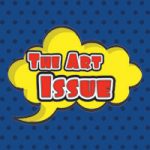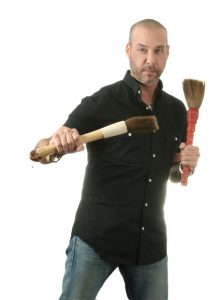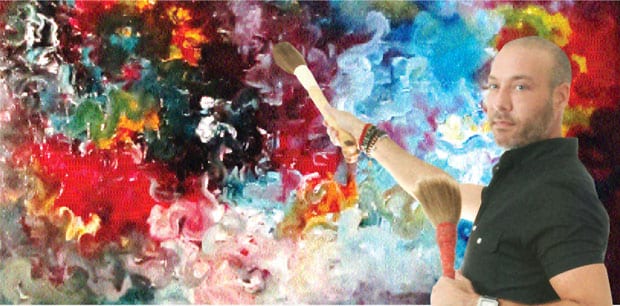Gay artist Baron Farha opens up about his process

ART AND SOUL | From his work at Fendi to his colorful abstracts — recently of dyes on Lucite — Baron Farha has evolved as an artist and creative person. (Terry Thompson/Dallas Voice)
STEVEN LINDSEY | Contributing Writer
stevencraiglindsey@me.com
Getting inside an artist’s mind is rarely easy. An exception is discussing the inspirations of Baron Farha — a gay Dallas artist who’s keenly in touch with his own creative process … even if some of it is beyond explanation.
Farha’s modern paintings have been seen in gallery exhibits, at charity auctions (one donated to the Black Tie Dinner earlier this month fetched $2,500) and hanging in the homes of both the rich-and-famous and everyday Joes. Many of his recent works have sold for thousands of dollars apiece.
But like most success stories, Farha’s had humble beginnings.
“I moved to Dallas from Oklahoma City with a $100 bill in my pocket. I hate to say it, but I stayed at a hotel on Harry Hines for two weeks. I think it was called the Anchor Inn. It was like $19 a day,” he says. “My mom was not happy. I made that work and then I stayed with a friend. One night I was out at Village Station [forerunner of S4], found my roommate there, got a job bartending at Pappadeaux, and then I decided to start college.”
Farha got his degree in interior design from the Dallas Art Institute and though he’s very successful in that field today, his heart has always beaten for the art he creates with his own two hands. “My career has been an evolutionary process,” he says.
His mother and teachers knew early on that Farha had a creative gift. “My mom always had me in art classes and the teachers saw something there. I tried the sports thing and that didn’t work. I was a very creative, introverted child, but as I got older I found that I could be at peace with who I was and I could find my own style.”
Farha always waits for his visions, which often come in the middle of the night.
“My inspiration happens a lot while I’m asleep,” he says. “My dreams are in a very vivid kaleidoscope of colors and I remember everything. I keep a notebook by my bed. If I dream of something, I write it down. If it’s really important, I’ll get up and work on it right then.”
Such ephemeral inspiration may account for why there’s nary a rhyme or reason in what Farha paints or what colors he uses.
 “It’s trying to connect my mind and heart at the same time,” he says. “It’s a daunting process, so I drink a lot of wine to get super relaxed. I can’t be stressed out when I paint or I waste paint.”
“It’s trying to connect my mind and heart at the same time,” he says. “It’s a daunting process, so I drink a lot of wine to get super relaxed. I can’t be stressed out when I paint or I waste paint.”
His mental state at the moment also plays a big part.
“I paint with my emotions. When I’m happy, when I’m sad, you can really tell. I went through a bad breakup seven years ago and it came out in the art for sure. Things pop up in art that are unexpected. A lot of people see angels in my artwork, I don’t know why, but maybe they’re there for a reason. I like to think that somebody’s leading my hand as I paint.”
Most importantly, Farha has come to terms with how subjective art is to those viewing it.
“My painting is very, very modern. It’s not for everybody. You’re either going to like it you’re going to hate it. There’s no in between and I’m fine with that. If you don’t like it, the guy behind you will.”
For him, beauty is truly in the eye of the beholder — or in this case, the owner of the artwork.
“That’s why I don’t ever sign anything on the front,” he says; “It’s always signed on the side. Work can be turned in any direction. I’ll go to a client’s house and a client will have it displayed completely upside-down from how I painted it, but then I’ll see something different. It’s great.”
For the past several years, he’s gained plenty of devoted collectors. But he wasn’t an overnight success.
“I can remember the first thing I painted,” he recalls. “I would never let it be seen at this point. I have a lot of God mistakes, as I call them, because there’s no [excuse] for how they end up. Like this new method I’m doing: dye on Lucite. It was a complete mistake, but it’s going over really well. Black Tie Dinner was the first time where it was really seen by people.”
Farha says some of his biggest early supporters were in the gay community, so that’s where he first focused his efforts. Then, his base broadened. “My most expensive piece of artwork is now hanging in Tyler, in an oil tycoon’s house,” he laughs. That painting sold for $9,500, a proud accomplishment that he memorialized in a tattoo on his arm with the date of the sale. It serves as a reminder of his good fortune — something he doesn’t think would ever have happened without being poor and hungry.

“I’ve been so poor that I’ve used coffee grounds before to get texture in the paint,” he admits. “I paint with anything. It doesn’t necessarily have to be a paintbrush. I do a lot of really cool work just with my hands. I build all my frames and stretch my own canvases. I stopped working with oils because it took so long to dry.”
Though he had a professional studio for a while, he’s gone back to how he worked in leaner times.
“I work in my living room. It’s very old-school, like in college, when I’d eat ramen noodles. Now I just move the furniture out of the way and there’s paint on everything. My hands have dye on them right now because I don’t wear gloves, though I probably should.”
The former Fendi designer has always had an eye for the artistic no matter where his career paths take him. So in addition to his current interior design business, he plans to launch a retail store next year with his own furniture line, too. At that point, his personal artistic vision — whether it’s his own creations or his interior design work — can literally fill an entire home … getting Baron Farha that much closer to becoming a household name.
This article appeared in the Dallas Voice print edition November 28, 2014


















